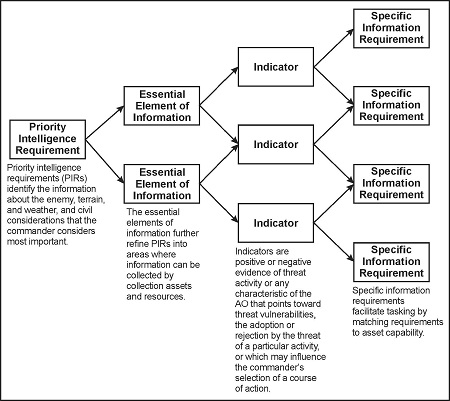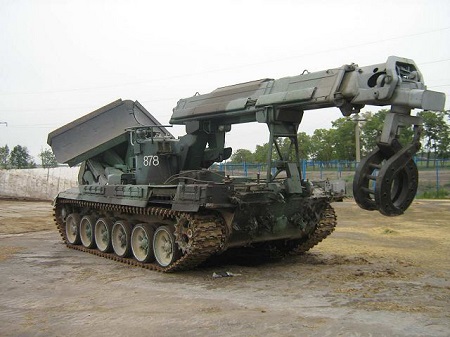The Importance of Priority Intelligence Requirements to the Army Service Component Command (ASCC) and the Intelligence Apparatus
James King
Most Military Intelligence Brigades, Theater [MIB (T)] have an Analytical Control Element (ACE) and Collection Battalion supporting the Army Service Component Command (ASCC). In order to focus the intelligence enterprise, the MIB (T) and the G2 use Priority Intelligence Requirements (PIR) as its main driver to focus the intelligence apparatus. Because the ASCC has a larger footprint to support than a maneuver Division ACE, a PIR-driven analytical process is critical in order to manage the organizational resources throughout the depth of the Area of Operations (AO). Other business practices compliment the process, too, such as (1) Area of Intelligence Responsibility (AOIR) for collection, analysis, production, and dissemination; (2) Intelligence Handover Lines (IHL) for mission federation; (3) PIR-SIR-SOR-SDR for sensor synchronization; and (4) intelligence architecture for sensor and apparatus customization. All are highly effective tools for painting the picture of the battlefield for the commander, yet this level is synchronization is often underused or incorrectly implemented in the intelligence enterprise. In the U.S. Army Intelligence & Security Command (USINSCOM), proper implementation of the intelligence apparatus, using a PIR-driven methodology and enterprise synchronization, is part of a Line of Effort (LOE) for most Brigade Commanders and the HQs, as it is key task to set the theater.
What is a Priority Intelligence Requirement?
From the Collection Battalion to the Army Service Component Command (ASCC), PIR (and the analysis that goes into answering them) are one the most important tasks of the Intelligence enterprise. The handful of simple questions contained within the Commander’s Critical Information Requirements guide the intelligence collectors and analysts towards providing the commander the information needed to make timely and accurate decisions. These questions focus the analytical energy of the organization and provide areas of emphasis for collectors. Without this focus collectors and analysts are left to determine for themselves what they think the priority is. This is no more important than at the theater or ASCC level. With responsibility in most cases for an entire continent, Army Service Components must accurately prioritize their information requirements or risk being overwhelmed by information. Therefore, commanders and ASCC G2s must ensure an optimized intelligence enterprise by preserving and stewarding intelligence capabilities as well as the intelligence core tasks (e.g. collection by Area of Intelligence Responsibility (AOIR), processing, exploitation and dissemination (PED), analysis, and intelligence synchronization.
A PIR, along with Friendly Force Information Requirements (FFIR) and Essential Elements of Friendly Information (EEFI), is one of the three components of a Commander’s Critical Information Requirement which is outlined in ADRP 5-0 as, “an intelligence requirement, stated as a priority for intelligence support, that the commander and staff need to understand the adversary or the operational environment (JP 2-0). PIRs identify the information about the enemy and other aspects of the operational environment that the commander considers most important.”[i] Answering a PIR will result in one of the commander’s decision point criteria being met.

Figure 1. PIR Linkages
A PIR is composed of four parts which build upon each other. As depicted in Figure 1 each subsequent part of the PIR forms a subset of the part before it. Below is a description of each of the components of a PIR and how they fit together.
Part 1 - The Priority Intelligence Requirement: This is the overarching question that needs to be answered. Where is the enemy and what is he going to do? Examples of good PIR include: “Where will the Donovian commander commit his breaching force?” “How will the Donovians use chemical weapons?” Most non-intelligence soldiers only ever see this part of the equation. Answering this question, however, is the goal of the rest of the process.
Many people make the mistake of trying to encompass more than one question into a PIR, “When and where will the Donovian commander used his fixing force?” This question is asking two distinct things, when will the commander use his forces and where will he use them. A more appropriate way to ask the question is, “How will the Donovian commander use his fixing forces?” As will be illustrated in the later sections of this piece, answering this question as apposed to the previous one can provide more detailed insights into the enemy commander’s thought process and can trigger the blue force commander to make a decision.
Part 2 - Essential Elements of Information: The first subcomponent that a PIR is comprised of is the Essential Elements of Information or EEI. These EEI refine the Priority Intelligence Requirement. Using the example PIR above “How will the Donovian commander use his fixing forces?” and previously developed enemy courses of action, EEIs are used to identify all the possible locations the Donovian commander could feasibly use his fixing forces during his attack. In this example the EEIs for this PIR would look something like, “Will the Donovian commander use his fixing force against Alpha Company in Granite pass?” or “Will the Donovian commander use his fixing force against Charlie Company in the Central Corridor?”
These are two distinct questions that have a positive or negative answer. Each of the EEI that make up a PIR must be answered for that Priority Intelligence Requirement to be considered completely answered. But as can be seen in the example above once those EEIs are answered the blue force commander will have a clearer understanding of the battlefield which will allow him to make an effective decision. In this example knowing that the Donovian commander will commit his fixing force against Alpha Company in Granite Pass may cause the blue force commander to reinforce one of his other units in anticipation of the enemy’s main force.
Part 3 - Indicators: How does the analyst know he or she has answered an EEI? The analyst must know what information to look for, in this example the analyst must know what a fixing force is, what a fixing force typically is comprised of, and how the enemy deploys a fixing force either by their doctrine or by knowing how the enemy they are up against has used them in the past. This information is known as indicators. As the name implies this is the information that indicates what the analyst is looking for is actually taking place.
The Indicator tells the collector what information the analyst wants to know about about. The best indicators are things that are unique about a formation. For example, an enemy breaching element will likely have with it some sort of engineer asset designed for clearing obstacles. So, an indicator of where the enemy commander is going to employ his breaching force is the location of the IMR-2, a very distinct looking piece of equipment, within the enemy force.

Figure 2. Engineer Obstacle Clearing Tracked Armored Vehicle Russian (MR-2 IMR-2M1)
The size or make up of a force might also be an indicator of what type of element it is but there could be some danger in using an indicator like this. The collector may become fixated on counting equipment and only reporting when they see the exact size force described by the indicator. If the enemy force has been reduced more significantly then the analyst understands, something that happens frequently as accurate battle damage assessments are hard to do in the middle of combat, then the collector may never see the element described by the indicator because its size doesn’t match.
Part 4 - Specific Information Requirements: The last part of a PIR is the Specific Information Requirement (SIR). This is information that helps to coordinate what type of collection asset would best be able to collect the information needed to answer the PIR. This important but often overlooked aspect of the PIR can help the collection manager to properly assign collectors. Would an overhead satellite image effectively answer the question or do you need Ground Moving Target Indicators (GMTI) because the PIR can only be answered by the detection of movement? The SIR is where the analyst can identify those requirements.
Answering the Priority Intelligence Requirement
Once the Priority Intelligence Requirement has been broken down into its component parts and the collection assets have been assigned to collect against the requirement the organization can begin the process of answering the PIR. The collection assets as designated in the SIRs collect on their assigned targets using their specific method of collection. Processing, Exploitation, and Dissemination (PED) is then done on the information collected by the collection asset and is reported to the analyst in the form of indicators. The analyst digests these indicators while working towards answering the Essential Elements of Information. Once all the EEIs of a given Priority Intelligence Requirement have been confirmed the analyst can confidently state that a PIR has been answered. This in turn will cause a trigger to be met on the decision support matrix (DSM). This trigger being met will require the commander to implement that decision.
Using the example PIR from above, “where will the Donovian commander commit his breaching force”, the process looks something like this.
- Priority Intelligence Requirement 1: Where will the Donovian commander commit his breaching force?
- Essential Element of Information 1: Will the Donovian commander commit his breaching force against 1-24IN in the central corridor?
- Essential Element of Information 2: Will the Donovian commander commit his breaching force against 1-5IN in Alpha/Bravo pass?
- Essential Element of Information 3: Will the Donovian commander commit his breaching force against 3-21IN in Siberian Ridge?
- Indicator1: IMR-2s following a large formation T-72 main battle tanks and/or BMPs moving in attack formation.
- Indicator2: Small platoon to company size combat force committed in to one or more of the battalion battle positions.
- Specific Information Requirement: Full Motion Video of enemy formation, SIGINT collection, Cavalry Observation Post report of enemy movement.
The Collection Manager would then take the PIR worksheet and assign collection assets to fulfill the requirements. Using this example let’s say the collection manager assigned a Shadow Unmanned Aerial System to observe a Named Area of Interest to the front of 1-24IN’s and 1-5IN’s battle positions, and a Scout Platoon Observation Post is in front of 3-21IN’s position. A JSTARS is flying in support and will provide queuing for the Shadow to transition it between the two battle positions depending on the size of the formation identified by the GMTI tracks. The GMTI indicates that a company size formation is moving towards 3-21IN and 1-5INs positions and a larger battalion size element is moving towards 1-24IN’s position. The Shadow queued by the JSTARS flies over the enemy formation and identifies 2 IMR-2 obstacle clearing vehicles following a large formation of tanks and BMPs headed towards 1-24IN’s position.
Using the indicators reported by the Shadow and JSTARS the analyst has determined that EEIs 1,2, and 3 have been answered. Two small fixing forces are moving towards 1-5IN and 3-21IN’s position and the larger breaching force indicated by its size and composition is headed towards 1-24IN’s position. The analyst realizes that all the elements of the Priority Intelligence Requirement have been satisfied thus answering the overall PIR of where will the Donovian commander commit his breaching force? The answer to this PIR ends up being, the Donovian commander will commit his breach against 1-24IN’s battle positions. The answering of this PIR causes the triggering of a Decision Point. Which results in the Brigade commander executing the decision to commit the reinforcing element to 1-24IN’s position. This in turn prevents the enemy from successfully breaching the battle positions and ultimately defeats the enemy attacking force. While this is a simplified example the process can work just as simply and straight forward in an actual combat situation.
Campaign vs Mission Specific PIR
One of the misnomers regarding Priority Intelligence Requirements is that there can be only one set at a time. This is not true. In fact, having both campaign PIR which are enduring questions that must be tracked for an extended period of time and mission specific PIR which only pertain to one specific operation is important to ensuring the right people get the right intelligence.
Campaign PIRs are enduring questions that could take several years to answer if there ever truly can be a definitive answer. These PIR are generally established at the operational or strategic level in order to track the effectiveness of their campaign plan or to provide indicators and warnings of the potential need to initiate a contingency plan. Examples of these type of PIR include:
- What activities are Donovia conducting within the AOR which affect US interests, access, or influence?
- What activates, operations, transnational organizations, networks, and/or entities within Atropia pose the greatest threat to regional security/stability?
When considering the scope of a Combatant Command (COCOM) and the potential actors operating within their Area of Responsibility campaign PIR are vital to focus the analyst on the events and personalities that their commander believes are important. Having campaign PIR however, in no way prevents the analyst from bringing forth a topic not covered by them.
The PIR examples used to illustrate the previous sections are good examples of mission specific PIR. These PIR have a short shelf life, usually only lasting a timeframe just before and just after an operation is executed. They are crafted as described above in order to assist the analyst in supporting the commander’s decision making. They tell the analyst what information the commander needs most in order to make decisions that can potentially change the outcome of the mission and save soldier’s lives.
These two types of PIR can peacefully co-exist. Analysts can shift focus for a short period to shift their attention to specific mission priorities without completely dropping sight of the overarching campaign. Nor do mission commanders have to settle for PIR that don’t give him the answers he needs to make a decision.
Nesting
To be truly effective, a unit’s PIRs must be nested with that unit’s next higher echelon’s PIR. Doing so allows the lower echelon to leverage the analytical power and collection capability of the next higher headquarters. Not every one of a unit’s PIR will be able to be nested with a PIR from the higher headquarters but the more that are, particularly ones that are tied to the next higher headquarters’ main effort or top priority, the more help from higher a unit will typically get. If for example your higher headquarters is concerned about drug trafficking and you know that drugs flow freely through your area of responsibility having a PIR regarding drugs that aligns with your higher headquarters will help to give you a higher priority for collection and analytical support. It also tells the higher headquarters that helping you answer your PIR helps them answer theirs potentially making them more willing to assist you.
Conclusion
Using PIRs properly make them a powerful analytical tool that can effectively shape the commander’s decision making and ultimately save lives on the battlefield. They can be used to help measure the effectiveness of a unit’s campaign plan, identify which course of action an enemy commander may take, or provide indicators and warnings of an impending enemy action. However, they are only effective when used properly and crafted smartly. Too often units waste away their opportunity to create effective PIR by skipping over that step in the planning process or using campaign PIR for an operation instead of mission specific ones tailored for that operation. Intelligence professionals must take the time to use these tools effectively.
End Note
[i] U.S. Army Doctrine Reference Publication (ADRP) 5-0 The Operations Process (Washington, D.C.: U.S. Government Printing Office [GPO], 17 May 1012) 1-6

